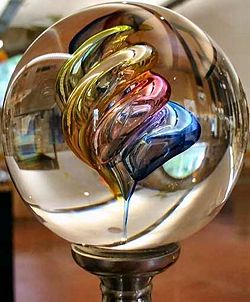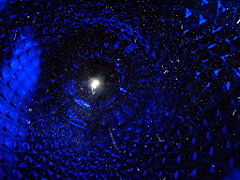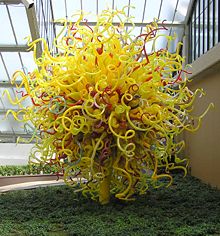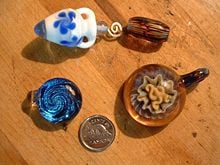Glass
- This article refers to the material known as glass. For other uses, see Glass (disambiguation).
The material definition of glass is a uniform amorphous solid material, usually produced when a suitably viscous molten material cools very rapidly to below its glass transition temperature, thereby not giving enough time for a regular crystal lattice to form. By far the most familiar form of glass is the silica-based material used for windows, containers and decorative objects.
In its pure form, glass is a transparent, relatively strong, hard-wearing, essentially inert, and biologically inactive material which can be formed with very smooth and impervious surfaces. These desirable properties lead to a great many uses of glass. Glass is, however, brittle and will break into sharp shards. These properties can be modified, or even changed entirely, with the addition of other compounds or heat treatment.
Common glass contains about 70% amorphous silicon dioxide (SiO2), which is the same chemical compound found in quartz and its polycrystalline form, sand.
History of glass
Glass has been considered a valuable material since early in human history. During the Stone Age, flint knappers used obsidian, a naturally occurring glass, to make extremely sharp knives. In addition, in early civilizations, small pieces of colored glass often rivaled precious gems as jewelry items. With the passage of time, it was discovered that if glass is heated until it becomes semi-liquid, it can be shaped and left to cool in a new, solid, independently standing shape.
Instructions to make glass were first documented in Egypt around 1500 B.C.E., when glass was used as a glaze for ceramic items before they were fired. In the first century B.C.E., the technique of blowing glass was developed, and what had once been an extremely rare and valuable item became much more common. At the time of the Roman Empire, many forms of glass were created, usually for vases and bottles. The glass was made from sand, plant ash, and lime (calcium oxide).
The color of "natural glass" usually varies between green and bluish green, based on the differing amounts of naturally occurring "impurities" of iron in the sand. Even today, common glass usually has a slight green or blue tint, arising from the same types of impurities. By contrast, obsidian, which is produced from volcanic magma, contains impurities that give it a black color.
Glassmakers learned to make colored glass by adding metallic compounds and mineral oxides to produce brilliant hues of red, green, and blue—the colors of gemstones (see Array of colors below). When gem-cutters learned to cut glass, they found that clear glass was an excellent refractor of light, causing the glass to sparkle. Consequently, the popularity of cut clear glass soared, while that of colored glass diminished.
Glass objects from the seventh and eighth centuries have been found on the island of Torcello near Venice. These items form an important link between the Roman era and the later period, when that city gained importance in the production of the material. About 1000 C.E., an important technical breakthrough was made in Northern Europe, when soda glass was replaced by glass made from a much more readily available material: potash obtained from wood ashes. From this point on, northern glass differed significantly from that produced in the Mediterranean area, where soda remained in common use.
The eleventh century saw the emergence, in Germany, of a new approach to making sheet glass. The process involved blowing the glass into spheres, swinging them out to form cylinders, cutting them while still hot, and then flattening the sheets. This technique was perfected in thirteenth-century Venice.
From the fourteenth century onward, the center for glass-making was Venice, where many new techniques were developed. Venice became the hub of a lucrative export trade in dinnerware, mirrors, and other luxury items. Eventually, some of the Venetian glassworkers moved to other parts of northern Europe, and glass-making spread with them.
Around 1688, a process for casting glass was developed, which led to its becoming a much more commonly used material. The invention of the glass pressing machine in 1827 allowed the mass production of inexpensive glass articles.
Specialized glass-making processes
Prior to the twentieth century, various methods of making hand-blown glass were developed. The different types of glass produced by these processes were known as crown glass, blown plate, polished plate, broad sheet, and cylinder blown sheet. These methods of manufacture lasted at least until the end of the nineteenth century. The early twentieth century marked the move away from hand-blown to machine-manufactured glass, such as rolled plate, machine drawn cylinder sheet, flat drawn sheet, single and twin ground polished plate and float glass.
The process for making crown glass was first perfected by French glassmakers in the 1320s, notably around Rouen. In this process, glass was blown into a "crown" or hollow globe, which was then reheated and spun out into a flat disk, up to 5–6 feet (1.5–1.8 meters) in diameter. Because of the manufacturing process, the best and thinnest glass would lie in a band at the edge of the disk, while the glass became thicker and more distorted toward the center. To fill large window spaces, many small diamond-shaped pieces would be cut from the edge of the disk, mounted into a lead lattice work, and fitted in the window. The process was kept a careful trade secret for centuries. As a result, crown glass was not made in London until 1678.
Broad sheet glass was made by blowing molten glass into an elongated balloon shape with a blowpipe. Then, while the glass was still hot, the ends were cut off and the resulting cylinder was split with shears and flattened on an iron plate. The quality of broad sheet glass was not good, with many imperfections. Cylinder blown sheet was created using a similar process, but a larger cylinder was made by swinging it in a trench. The process produced much larger panes and improved surface quality over broad sheet. Blown plate was made from broad sheet glass by laboriously hand grinding and polishing both surfaces. It was of sufficient quality and size for mirrors and coach glasses.
The cylinder method of creating flat glass was first used in the United States by William J. Blenko in the 1920s.
Art is sometimes etched into glass via acid or other caustic substance (causing the image to be eaten into the glass). Traditionally this was done by a trained artisan after the glass was blown or cast. In the 1920s a new mould-etch process was invented, in which art was etched directly into the mould, so that each cast piece emerged from the mould with the image already on the surface of the glass. This reduced manufacturing costs and, combined with a wider use of coloured glass, led to cheap popular glassware in the 1930s, which later became known as Depression glass.
See also: Polished plate, Cylinder blown sheet, Machine drawn cylinder sheet
Stained glass
File:Stained.buckfast.750pix.jpg Buckfast Abbey, Devon, England. The panel is about 8 metres (26 feet) across. It was designed by the monks who live in the abbey |
The term stained glass generally refers to glass that has been colored by adding metallic salts during its manufacture. For example, copper can be used to produce green or blue glass. The molten glass is then annealed in a furnace to produce sheets of colored glass. Early artists working with stained glass were limited to a few primary colors, but today almost any color can be produced. If fine details such as shadows or outlines are required, the artist paints them on the cold glass with special paint made from metal oxides. The piece is then fired in a kiln, causing the oxides to fuse permanently with the glass. Stained glass is now available in a variety of textures that alter the color transmission characteristics of the glass and produce surprising effects.
The process of making stained-glass windows involves cutting colored glass into different shapes, assembling the pieces (using lead came strips or copper foil), soldering them together, and installing them in a frame. This process is both an art and a craft. It requires artistic skill to conceive of the design and engineering skill to assemble the structure so that it can support its own weight and (for a window) survive the elements.
History of stained glass
Begun in Eastern Asia and among Muslim designers, the art of stained glass reached its height in the Middle Ages, particularly 1150-1250. As the solid Romanesque wall was eliminated, the use of glass dramatically expanded. Integrated with the lofty verticals of Gothic cathedrals, large windows afforded greater illumination that was regarded as symbolic of divine grace.
In the nineteenth century, Romanticism and the Gothic revival caused renewed interest in stained glass. Important contributions to the art were made by William Morris (English, 1834-1898), Edward Burne-Jones (English, 1833-1898), John La Farge (American, 1835-1910) and Louis Comfort Tiffany (American, 1848-1933).
After centuries of repetition and little innovation, stained glass underwent a major renaissance of form. The impetus for this new modern glass was the restoration of thousands of church windows throughout Europe, destroyed by World War II. German artists led the way, as Ervin Bossanyi, Ludwig Schaffrath, Johannes Shreiter, and many others transformed an ancient art form into a contemporary one.
Properties and uses
One of the most obvious characteristics of ordinary glass is that it is transparent to visible light, although not all glassy materials are. In addition, ordinary glass absorbs (and blocks) ultraviolet (UV) radiation—it partially blocks UVA (wavelengths 400 and 300 nm), and it totally blocks UVC and UVB (wavelengths below 300 nm). This property is due to the presence of compounds such as soda ash (sodium carbonate) in the glass.
The main constituent of glass is silica (SiO2). Pure silica glass (also called fused quartz) does not absorb UV light and is used for applications that require transparency in this region, although it is more expensive. This type of glass can be made extremely pure and used to make fiber optic cables, which transmit light over long distances. Undersea cables have sections doped with erbium, which amplify transmitted signals by laser emission from within the glass itself.
Ingredients in glass
Although pure silica can be converted into glass for special applications, it has a melting point of about 2000 °C (3600 °F). The melting point is lowered to about 1000 °C (1800 °F) by adding either soda (sodium carbonate) or potash (potassium carbonate). The presence of soda, however, also makes the glass water soluble, which is usually undesirable. Therefore, lime (calcium oxide) is added to the mix, to restore insolubility. The resultant glass contains about 70% silica and is called soda-lime glass. This type of glass accounts for about 90% of manufactured glass.
Besides soda and lime, other ingredients are usually added to impart a variety of properties to glass. For instance, when lead oxide is added, the resultant "lead crystal" has a much higher refractive index than normal glass, and consequently much greater "sparkle". The addition of barium also increases the refractive index. If boron is added, it alters the thermal properties of glass, making it more resistant to breakage during rapid changes in temperature. This is a feature of Pyrex glass, a brand name for borosilicate glass.
Thorium oxide was formerly used in producing high-quality lenses, but it is radioactive and has been replaced by lanthanum oxide. Large amounts of iron are used in glass that absorbs infrared energy, such as for heat-absorbing filters in movie projectors. Cerium(IV) oxide can be used for glass that absorbs ultraviolet (UV) radiation, which damages DNA and living tissue. Additional ingredients may be added to produce glass in a wide range of colors (see below).
Biologically active ingredients
Scientists can now make glass vessels in which biologically active molecules, such as enzymes, are embedded. These vessels can then be used to carry out reactions catalyzed by the enzymes. Preparation of this type of glass, however, cannot be carried out by the usual, high-temperature methods, because the heat would destroy the enzymes. Instead, it is prepared by an innovative approach that falls in the category known as polymerization. One example of this approach is called the sol-gel process.
Array of colors
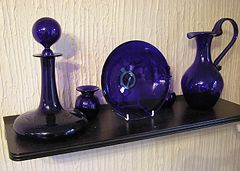
Glass with a wide range of colors can be produced by adding different metals and metal oxides during the manufacturing process. For instance, when manganese is added in small amounts, it removes the green tint lent by iron; and at higher concentrations, it produces an amethyst color. Selenium, likewise, can be used at low concentrations to decolorize glass, but at higher concentrations, it imparts a reddish color. At low concentrations (0.025–0.1%), cobalt yields blue glass.
The oxides of tin, antimony, and arsenic produce an opaque white glass, first used in Venice to produce an imitation porcelain. Copper oxide, at a concentration of 2–3%, produces a turquoise color.
Metallic gold at low concentrations (around 0.001%) produces a rich, ruby-colored glass, and at lower concentrations it produces a less intense red, often marketed as "cranberry". Pure, metallic copper produces a dark red, opaque glass, and it is sometimes used as a substitute for gold in the production of ruby-colored glass. Nickel, depending on its concentration, produces blue, violet, or even black glass. Adding titanium produces yellowish-brown glass.
Uranium (0.1–2%) can be added to give glass a fluorescent yellow or green color. Uranium glass is typically not radioactive enough to be dangerous, but if ground into a powder (such as by scraping with sandpaper) and inhaled, it can be carcinogenic. Silver compounds (notably silver nitrate) can produce a range of colors, from orange-red to yellow. The way the glass is heated and cooled can significantly affect the colors produced by these compounds, but the chemistry involved is complex and not well understood. New shades of colored glass are frequently discovered.
Glass tools
Since glass is strong and unreactive, it is a very useful material. Many household objects are made of glass. Drinking glasses, bowls, and bottles are often made of glass, as are light bulbs, mirrors, the picture tubes of computer monitors and televisions, and windows. In laboratories doing research in chemistry, biology, physics and many other fields, flasks, test tubes, lenses and other laboratory equipment are often made of glass. For these applications, borosilicate glass (such as Pyrex) is usually used for its strength and low coefficient of thermal expansion, which gives greater resistance to thermal shock and allows for greater accuracy in laboratory measurements when heating and cooling experiments. For the most demanding applications, quartz glass is used, although it is very difficult to work. Most such glass is mass-produced using various industrial processes, but most large laboratories need so much custom glassware that they keep a glassblower on staff. Volcanic glasses, such as obsidian, have long been used to make stone tools, and flint knapping techniques can easily be adapted to mass-produced glass.
Glass art
Even with the availability of common glassware, hand blown or lampworked glassware remains popular for its artistry. Some artists in glass include Lino Tagliapietra, Rene Lalique, Dale Chihuly, and Louis Comfort Tiffany, who were responsible for extraordinary glass objects. The term "crystal glass", derived from rock crystal, has come to denote high-grade colourless glass, often containing lead, and is sometimes applied to any fine hand-blown glass.
There are many techniques for creating fine glass art; each is suitable for certain kinds of object and unsuitable for others. Someone who works with hot glass is called a glassblower or lampworker, and these techniques are how most fine glassware is created. Glass that is manipulated in a kiln is called warm glass, and traditional stained glass work is commonly called cold glass work. Glass can also be cut with a diamond saw, and polished to give gleaming facets.
Objects made out of glass include vessels (bowls, vases, and other containers), paperweights, marbles, beads, smoking pipes, bongs, dildos, and sculptures. Colored glass is often used, though sometimes the glass is painted; notable examples of painted glass include the work of contemporary artists Judith Schaechter and Walter Lieberman. Innumerable examples exist of the use of stained glass, such as those by John La Farge in Boston's Trinity Church, or the life-sized sculptures among the fine art of Jim Gary.
The Harvard Museum of Natural History has a collection of extremely detailed models of flowers made of painted glass. These were lampworked by Leopold Blaschka and his son Rudolph, who never revealed the method he used to make them. The Blaschka Glass Flowers are still an inspiration to glassblowers today. See the Harvard Museum of Natural History's page on the exhibit for further information.
Stained glass is an art form with a long history; many churches have beautiful stained-glass windows.
Glass in buildings
Main articles: Architectural Glass and Glazing
Glass has been used in buildings since the 11th century. Typical uses for glass in buildings include as a transparent material for windows in the building envelope, as internal glazed partitions and as architectural features.
Glass in buildings can be of a safety type, including wired, toughened and laminated glasses.
Glass fibre insulation is common in roofs and walls. Foamed glass, made from waste glass, can be used as lightweight, closed-cell insulation.
Several methods of producing glass for applications have been developed, including:
- cylinder glass
- sheet glass
- rolled plate glass
- polished plate glass
- float (annealed) glass
- figure rolled glass
These glass types can be further utilized by the following processes:
- laminating
- toughening
- chemical strengthening
- application of a self-cleaning catalyst
- double-glazing
See also Window.
Glass as a liquid
One common misconception is that glass is a super-cooled liquid of practically infinite viscosity when at room temperature (see amorphous solid). Supporting evidence that is often offered is that old windows are often thicker at the bottom than at the top. It is then assumed that the glass was once uniform, but has flowed to its new shape.
The likely source of this belief is that when panes of glass were commonly made by glassblowers, the technique that was used was to spin molten glass so as to create a round, mostly flat and even plate (the Crown glass process, described above). This plate was then cut to fit a window. The pieces were not, however, absolutely flat; the edges of the disk would be thicker because of centrifugal forces. When actually installed in a window frame, the glass would be placed thicker side down for the sake of stability and visual sparkle. Occasionally such glass has been found thinner side down, as would be caused by carelessness at the time of installation.
- Writing in the American Journal of Physics, physicist Edgar D. Zanotto states "...the predicted relaxation time for GeO2 at room temperature is 1032 years. Hence, the relaxation period (characteristic flow time) of cathedral glasses would be even longer" (Am. J. Phys, 66(5):392-5, May 1998). In layman's terms, he wrote that glass at room temperature is very strongly on the solid side of the spectrum from solids to liquids.
- If medieval glass has flowed perceptibly, then ancient Roman and Egyptian objects should have flowed proportionately more—but this is not observed.
- If glass flows at a rate that allows changes to be seen with the naked eye after centuries, then changes in optical telescope mirrors should be observable (by interferometry) in a matter of days—but this also is not observed. Similarly, it should not be possible to see Newton's rings between decade-old fragments of window glass—but this can in fact be quite easily done.
- Glass in refracting telescopes, with objective lenses of large diameter, is observed to sag under its own weight. This sag happens because the lens is only supported around its edge. The result is a loss of focus, and occurs not because the glass is flowing over time, but because it is not infinitely rigid. This (along with chromatic aberration and other effects) limits the size of refracting telescopes, with the largest refractor in the world being the Yerkes Observatory telescope with a diameter of 102 cm.
Note that pitch, another seemingly-solid material, is in fact a highly viscous liquid, 100 billion times as viscous as water. This property can be seen in the University of Queensland's pitch drop experiment, where each drop has taken approximately 10 years to fall into the beaker.
See also
- Art glass
- Beveled glass
- Bulletproof glass
- Cathedral glass
- Fibreglass
- Float glass
- Glass-reinforced plastic
- Glass Container Industry
- Crystal
- Lexan
- Magnifying glass
- Prince Rupert's Drops
- Pyrex
- Favrile Iridescent Glass - Tiffany's technique to make stained glass art
- Sea glass
- G. Owen Bonawit
- Marc Chagall
- Glass mosaic
- Glassblowing
- Glass beadmaking
- Hot glass
- Frank Lloyd Wright
- Tiffany lamp
- Louis Comfort Tiffany
- Sculpture
- Jim Gary
- Stained glass artists
- Venetian glass
ReferencesISBN links support NWE through referral fees
- "Do Cathedral Glasses Flow?" Am. J. Phys., 66 (May 1998), pp 392–396
- Noel C. Stokes; The Glass and Glazing Handbook; Standards Australia; SAA HB125-1998
- Glass Beads from Anglo-Saxon Graves: A Study on the Provenance and Chronology of Glass Beads from Anglo-Saxon Graves, Based on Visual Examination by Birte Brugmann
External links
- Corning Museum of Glass, especially Research, Teach, and Learn section.
- Is glass liquid or solid? by Philip Gibbs on the spr USENET physics FAQ
- Antique windowpanes and the flow of supercooled liquids
- article on the non-flowness of glass
- Page devoted to the AFU glass flow controversy, with links to citations
- Page stating that glass does not flow
- Substances used in the Making of Colored Glass
- Self-cleaning glass - Product information from Pilkington.
- The Straight Dope article on glass, article discusses why glass is a liquid treated as a solid
- Recycling Glass - Waste Management Issues
Stained glass
- The Stained Glass Museum (Ely, England)
- Stained Glass Photography
- Stained Glass Tutorials
- Stained Glass Artist From India
- Stained Glass from Northern Ireland
- Preservation of stained glass
- Tiffany Stained Glass from Northern Ireland
Credits
New World Encyclopedia writers and editors rewrote and completed the Wikipedia article in accordance with New World Encyclopedia standards. This article abides by terms of the Creative Commons CC-by-sa 3.0 License (CC-by-sa), which may be used and disseminated with proper attribution. Credit is due under the terms of this license that can reference both the New World Encyclopedia contributors and the selfless volunteer contributors of the Wikimedia Foundation. To cite this article click here for a list of acceptable citing formats.The history of earlier contributions by wikipedians is accessible to researchers here:
The history of this article since it was imported to New World Encyclopedia:
Note: Some restrictions may apply to use of individual images which are separately licensed.
